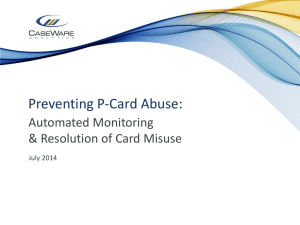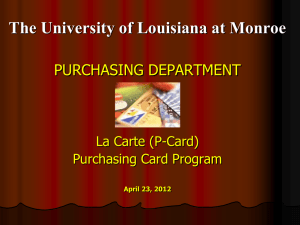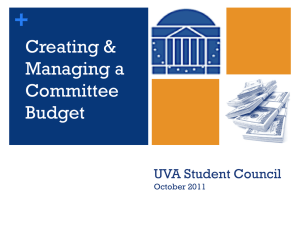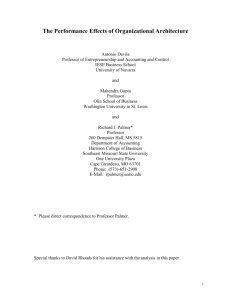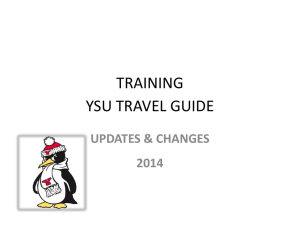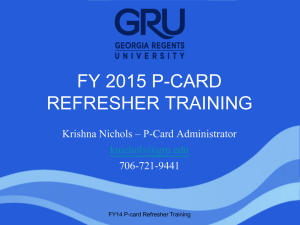Procurement Cards - Electronic Resource Center
advertisement
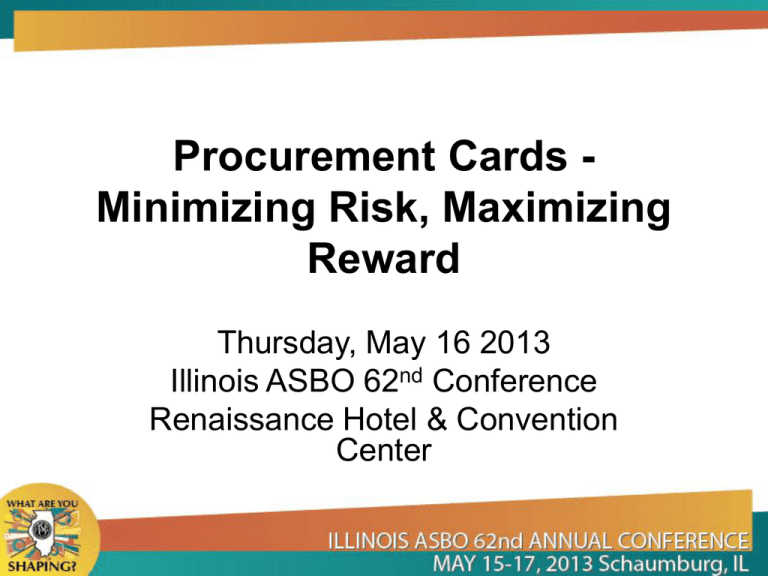
Procurement Cards Minimizing Risk, Maximizing Reward Thursday, May 16 2013 Illinois ASBO 62nd Conference Renaissance Hotel & Convention Center Speakers Jim Grammas, Vice President Government Team, BMO Harris Bank N.A., BOE Niles ESD 71 Member since 03/2010 Ronald R. O'Connor, Asst. Dir./Finance, Batavia USD 101. Member since 08/2009 Holly Wallace, Member Relations Specialist, Illinois Association of School Business Officials, BOE DeKalb CUSD 428 Member since 09/2005 Session Overview • What are p-Cards and how do they operate • BOE and the Law • How do school districts use p-Cards • The Illinois ASBO p-Card program What are p-Cards? A Purchasing Card (P-Card) is a type of Commercial Card that allows organizations to take advantage of the existing credit card infrastructure to make electronic payments for a variety of business expenses (e.g., goods and services). In the simplest terms, a P-Card is a charge card, similar to a consumer credit card. However, the card-using organization must pay the card issuer in full each month, at a minimum. P-Cards are also known as Procurement Cards (ProCards), Payment Cards, Purchase Cards or similar terms. Who Uses P-Cards? Organizations that use P-Cards come from the Corporate, Education and Government sectors and are often called "end-users." The individual employees who are issued a P-Card to initiate transactions/payments on behalf of their employer (the end-user organization) are known as "cardholders." What Does A P-Card Look Like? P-Cards are not limited to plastic cards; they can also take the form of nonplastic account numbers. The term "card" is typically used within the industry when describing any type of Commercial Card product, regardless of whether or not a plastic card is issued. Types of p-Cards • Personalized Card • Department Card • Ghost Card Other Types of Commercial Cards P-Cards are just one category of Commercial Card. Other Commercial Card products include the following. Each is intended to address different types of purchases and/or spend categories. • Corporate Card – commonly used by organizations for employee travel and entertainment (T&E) expenses; also referred to as a Travel Card • One Card – a single charge card that combines procurement with T&E and, in some cases, fleet charges • Fleet Card – a card product used by organizations to pay for fuel, maintenance, repair and related expenses on company vehicles • Prepaid Card – debit-based card, allowing the user to pay now versus later, as the card transaction amounts are deducted from a funded account; for example, a Payroll Card "loaded" with an employee's earned wages • Declining Balance Card – a card that typically does not require a pre-funded account; a spending limit and/or expiration date are established up-front, giving it a specific "shelf life" to accommodate a specific project budget or spend allowance; for example, a Meeting Card • Business Card – a credit card targeted for smaller businesses (in lieu of a P-Card), commonly used for a variety of expense types (e.g., goods, services, travel, etc.); the end-user organization may be allowed to carry a balance Why Use p-Cards? The traditional procure-to-pay process is costly • The transactional, or process cost, of using a traditional procure-to-pay process—often involving a requisition, purchase order, invoice and check payment—is the same regardless of the dollar amount of the purchase. In other words, the process cost of a $25 purchase is the same as a $10,000 purchase. Often, the process cost exceeds the value of the item being acquired (e.g., the cost to acquire a $25 wrench may exceed $100). Estimates of the process cost of the traditional process range from $50 to $200. Why Use p-Cards? A P-Card program simplifies the process • Most organizations recognize that a large number of check payments are made for lowvalue items to a large number of suppliers—a costly, inefficient process. When the payment method is switched from the traditional process to a Purchasing Card process, efficiency savings range from 55% to 80% of the traditional process cost. Why Use p-Cards? • Overall, P-Cards provide a means for streamlining the procure-to-pay process, allowing organizations to procure goods and services in a timely manner, reduce transaction costs, track expenses, take advantage of supplier discounts, reduce or redirect staff in the purchasing and/or accounts payable departments, reduce or eliminate petty cash, and more. Originally, P-Cards were targeted for these low-value transactions, but their use has expanded as the industry has grown p-Cards Also Benefit Suppliers Suppliers that accept P-Cards for payment can reap considerable benefits to outweigh the costs related to card acceptance. Benefits include: • cost reductions, such as eliminating invoice creation, handling and mailing; depositing payments and collection activities • electronically deposited funds • faster receipt of payments and improved cash flow • increased sales, as many organizations solicit only suppliers that accept P-Cards as payment • customer satisfaction • potential staff reductions within accounts receivable and the ability to redirect staff to more value-added activities The p-Card Process and Key Players Purchasing Cards (P-Cards) or non-plastic account numbers are issued to employees (i.e., cardholders) responsible for making purchases or payments on behalf of their employer; for example, cardholders can order and pay for office supplies via a supplier’s website. Suppliers accept P-Cards for payment, utilizing the existing credit card infrastructure for payment processing. Transaction data is captured by a supplier’s point-of-sale (POS) system and transmitted through the card network • The level of transmitted data depends on the supplier’s process and technology systems; data levels include: Date Level I Standard Level II Variable Data Level III Detailed Data Supplier Transaction Amount CustomerSales Tax Defined Code X X X X X X X X X X X X X Line-Item Detail X The p-Card Process and Key Players In addition to cardholders and suppliers, other parties are involved with the P-Card payment process: • Issuers work directly with end-users to implement and grow programs, issue cards and invoice posted P-Card transactions. The issuer uses the services of the networks and processors to facilitate card issuance, authorize transactions and provide data. Many financial institutions are issuers. Issuers are sometimes referred to as card "providers." • Merchant acquirers enroll suppliers in the card acceptance process and implement equipment and software solutions related to this purpose. In addition, they facilitate payment flow, including payment to suppliers. A merchant acquirer is sometimes referred to as a supplier’s bank. • Networks facilitate the movement of transactional data between the issuer and merchant acquirer and set the rules pertaining to card acceptance by suppliers. Organizations in this role include Visa, MasterCard and American Express. (Note: American Express also assumes the roles of issuer and merchant acquirer.) Networks are sometimes referred to as "associations" (an outdated term) or the card brand. • Processors provide various services to card issuers and merchant acquirers, which may include card production, statement printing, authorization and data delivery. How P-Cards Work The card issuer typically provides a single electronic invoice to the end-user organization—at a minimum of once per month—reflecting all cardholders and their respective P-Card transaction totals plus a grand total. An organization does not carry a balance, instead paying its card issuer in full (at a minimum of one payment per month) for all cardholders’ transactions. The organization processes the invoice, creating accounting entries and facilitating payment to the card issuer. How p-Cards Work With P-Cards, the end-user organization assumes liability for payment—the cardholder neither owes the card issuer nor makes payments. However, cardholders are expected to follow their organization’s policies and procedures related to P-Card use, including reviewing and approving transactions according to a set schedule (at least once per month). The organization can implement a variety of controls for each P-Card; for example, a single-purchase dollar limit, a monthly limit, Merchant Category Code (MCC) restrictions and so on. In addition, a cardholder’s P-Card activity should be reviewed periodically by someone independent of the cardholder. Board of Education and the Law • Illinois School Code 23: Section 100.70 If a school board has obtained and issued credit cards or procurement cards for the use of board members, the superintendent, or other district employees or officials to pay certain jobrelated expenses or to make purchases on behalf of the board or district or any student activity funds, or for purposes that would otherwise be addressed through a conventional revolving fund, then the board shall adopt a written credit card policy that at least: • 1)identifies the allowable types of purchases; • 2) provides for the issuing bank to block the cards’ use at unapproved merchants; • 3) limits the amount a card-holder can charge in a single purchase or within a given month; • 4) provides specific guidelines on purchases via telephone, fax, and the Internet; • 5) indicates the consequences for unauthorized purchases; • 6) requires card-holders to sign a statement affirming that they are familiar with the board’s credit card policy; • 7) requires review and approval of purchases by someone other than the card-holder or user; • 8) requires submission of original receipts to document purchases; • 9) forbids the use of a card to make purchases in a manner contrary to the requirements of Section 10-20.21 of the School Code [105 ILCS 5/10-20.21]; and • 10) indicates how financial or material rewards or rebates are to be accounted for and treated. Other Legal Requirements • Statement of Affairs • 1099 Reporting • Tax Deferred Purchases • Board Approval to enter into Contract BOE Expectations • • • • • • • Compliance with Law Cost to Run Program Controls Available Checks and Balances in Place Policy and Procedural Manuals Reporting Ease of Use Policy and Procedure Manual • • • • • Policies and procedures for use Policies and procedures for MISuse Parts can be individualized Samples of paperwork Tutorials Ideas • • • • • • Overview of program How to obtain a card Guidelines for us How to process card use Consequences Samples of paperwork Check List To Start A Program • Discussion with Superintendent/Board/Bus. Office • Research available programs • Develop Procedure Manual • Present to Board for Approval • Application/Implementation Start Up! • Start with a pilot group – start small • Re-evaluate procedure • Increase card Use • Re-evaluate program Ideas for Growing Your Program Analyze your spending habits Look at your check registry Get cards into the people who are doing the spending • Secretaries • Buildings and Grounds/Maintenance • High School Departments Look at your big purchases • Energy • Transportation • Food • Books • Technology Manage Your Program How the p-Cards work in Batavia Background • • • • • 700+ employees, 100 Procurement Cards Wide array of limits Majority of transactions from B&G $70,000-$90,000 on average per month Supervisory systems in place Obtaining A P-Card • Supervisor recommendation – Limit • Understanding through discussion/video – Training – What constitutes a legitimate purpose? • Signing agreement • Explanation of receipts – Description Purchase Process • Approved by supervisor? • Receipts (Itemized, tax-free) • Supervisors (vendor, date of purchase, time, items purchased, price, tax? Initial if OK) • Details Online Auditing Procedures • All receipts • Supervisor initials – “Gold Standard” • Account codes • Receipt matches Details Online • Transaction Report Transaction Report • • • • • • Name Account code Vendor Price Description of purchase Reviewed at Finance Committee All p-Card programs are NOT alike! Advantages of an Association Sponsored Program • • • • • • • Single Contract Creates a user group/support network Negotiation clout Due diligence costs eliminated No Costs No Fees No Charges Only 3 Possible costs to participating school • Late fee • ATM Charge – IF cash advance option is selected • Interest owed on any cash advance Billing Cycle Requirements • School District may choose a billing cycle cut-off of the 5th or the 20th. • Payment is due at Harris Bank within chosen grace (7,14,21 or 27) days of billing cycle cut-off. Customized Card design can display: • • • • • • Card holder name School District name and number and/or Tax ID 2 Lines of text per card Department Cards Ghost Cards Specific card use parameters can be established for each card • Transaction limits per charge • Monthly limits • Preferred Supplier Restriction Billing and Payment • Monthly Billing Statements – Available online • Payment Methods – Automated Clearing House – Check Benefits of a p-Card Program Easier on Accounts Payable • Submit one monthly payment vs. multiple payments to multiple vendors • Reduction in paperwork • Fraud prevention and protection through the Bank and MasterCard • Detailed reporting available 24 x 7 • Easy online administration and dedicated customer support • Control on spending limits and accepted vendors More Information For information, application documents, tutorials and other tools, please visit: www.illinois-pcard.com.

